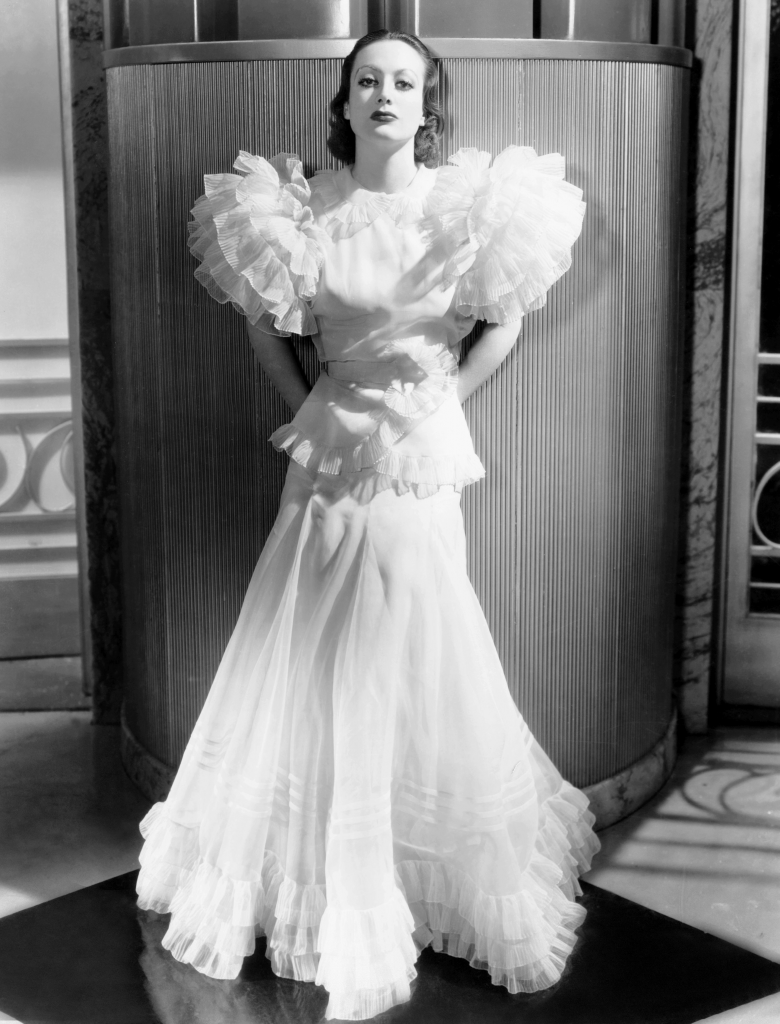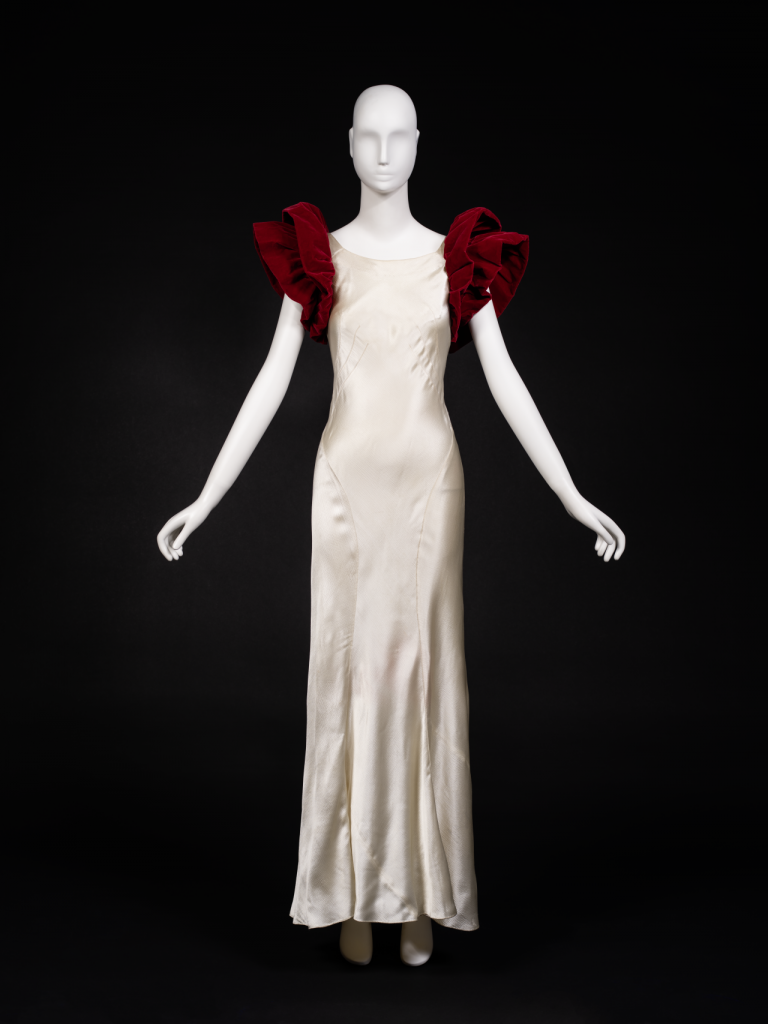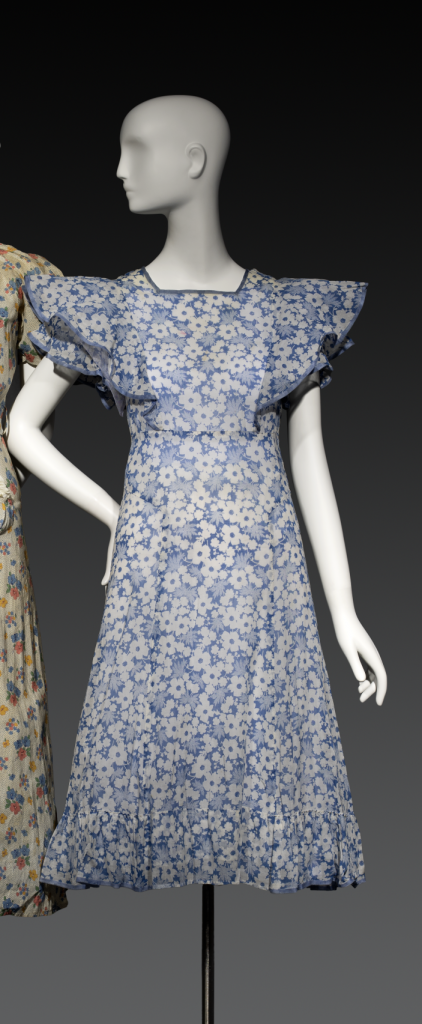Background
Movies and pop culture offered an escape. As the Great Depression dragged on and movie attendance decreased, movie studios invested more money in advertising. Movie stars were everywhere—on posters and billboards, in magazines, and on the radio.
One of the clearest examples of Hollywood’s influence on daily life was seen in fashion. Department stores sold clothing and dress patterns modeled on designs seen on the silver screen. Female actresses and their on-screen personas were strong, exciting, and sometimes dangerous. Everyday women aspired to look like their favorite film heroines, even if they could not afford a Hollywood lifestyle.
About the Image
In 1932, movie star Joan Crawford starred in the movie Letty Lynton. The movie is about a woman who murders her abuser and gets away with it by pretending to be innocent. Many women related to Letty Lynton, a character who wanted to escape a hard life for a new one. These three dresses demonstrate how movies could influence taste and fashion.
The first image shows Joan Crawford in character. The dress was designed by Gilbert Adrian to make her appear both innocent and flirtatious. It quickly became known as the Letty Lynton dress.
The second image shows a department store version of the Letty Lynton dress. Department stores quickly designed cheaper versions of the dress, and Macy’s claimed to sell over 50,000 Letty Lynton lookalikes. The layers and layers of fabric used in the original dress was difficult and costly to replicate, so only the big sleeves and elegant shape were copied. This dress is made of rayon and cotton, inexpensive materials that made it affordable for middle-class shoppers.
The final image shows a housedress from 1933. During the Great Depression, many women refashioned old clothes into something new. This dress is a repurposed summer dress. Although the maker wore it to do housework and run errands, the large sleeves echo the Letty Lynton style. Even housewives at home wanted to look and feel like glamorous heroines.
Vocabulary
- department store: A large store that sells a variety of goods in person or through a catalog.
- Gilbert Adrian: One of the most well-known costume designers for movies between the late 1920s and early 1940s. His most famous work was designing the costumes for The Wizard of Oz.
- Hollywood: The place in Los Angeles, California, where most movie studios were located and movie stars lived.
- housedress: An inexpensive and often homemade dress that was intended to be worn while cleaning, cooking, and running errands.
- rayon: An inexpensive man-made fabric. Often used as a cheap replacement for silk.
- silver screen: A term used to describe a movie theater screen.
Discussion Questions
- Why was Hollywood so important and influential during the Great Depression? Why were Americans drawn to movies and the media?
- What can we learn about society’s attitudes about women by studying these garments?
- How does the original Letty Lynton dress compare with the department store version?
- To what extent is the housedress related to the first two dresses?
- Why is it important to study fashion history? What do these three images tell us about taste, culture, and mass media in this era?
- Why do you think women liked the Letty Lynton dress style so much?
Suggested Activities
- Compare all three images with the images of recreation clothing from the Progressive Era. How did fashion for women change from the 1890s to the 1930s? Why do you think things changed so much?
- Pair this resource with the life story of movie star Anna May Wong to conduct a deeper dive into Hollywood history and influence.
- View the art extension activity for Modernizing America about fashion and department stores. Replace the Progressive Era images with the second image in this set. How would a 1930s department store market this dress to middle-class shoppers?
- Housedresses were an important part of housewives’ daily lives. Combine the third photo with the resource about keeping house on a budget.
- Americans were eager to find opportunities to escape their lives during the Great Depression. Combine this resource with the letter by Amelia Earhart. How does each represent a form of aspiration during a time of struggle?
- Consider how celebrities inspire fashion today. Ask students to keep a log of what they wear and to research one style or item that interests them. Where did that style come from and how did it become popular? Did certain celebrities or designers help bring it to a wider audience?
Themes
AMERICAN CULTURE









